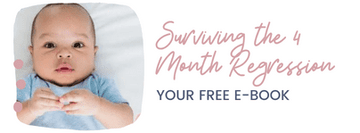
CASE STUDY: catnaps + night wakes were not sustainable for this exhausted mama
Violet's sleep story...
Violet was doing pretty well in the first few months and had been settling to sleep quite independently, however, mum Abbie began to experience difficulties with her daughter's daytime naps from around four months onwards.
Violet started catnapping all day long and after a while, her night time sleep took a bit of a hit too. Abbie was confident that she could navigate through this ‘rocky patch’ though and once the 4 month sleep regression had passed, she would be back on track.
During this regression, a strong feed-to-sleep association was formed and after a month, with no end in sight, Abbie decided this was no longer sustainable. She had become severely fatigued and very close to a postnatal depression diagnosis. At this point, Violet's nights had worsened and she had started to wake every 2 hours, on top of her continued catnapping through the day. Imagine not having to worry about your baby waking every 2 hours
Our award-winning Sleep Programs can make that happen in under 2 weeks.
Yes, I want sleep!
It was at this time that Abbie reached out to a close friend, who had also experienced sleep issues with her first child. She let Abbie know that had been using our Sleep Program for her second child since his birth and hadn’t experienced the same issues.
Right then and there, Abbie made the decision to purchase our Complete Sleep Program and started implementing some changes as soon as possible. She could see that some things needed adjusting in Violet's day - the times that she was being offered naps, her awake windows, and the way she was being settled to sleep had all been contributing to her catnapping and night waking.
Like a lot of new parents, Abbie didn't realise that the 4 month regression is a permanent change to a baby's sleep patterns. During this time, a baby's sleep cycles become more organised and obvious and babies can start full waking between each cycle in the day (every 35-45 minutes) and overnight (every 2 hours).
Sometimes, it's simply a case of tweaking a baby's awake windows to improve their sleep but more often than not, the key to getting through this regression is to guide your baby towards self-settling. After adjusting Violet's awake times, Abbie started following our Fed to Sleep self-settling method to gradually move away from feeding Violet to sleep.
With this method, she was able to assist Violet to sleep in a hands-on way, comforting her with feeding if she got upset. Much to Abbie's surprise, it only took 2 days before Violet was falling asleep happily on her own. The act of going to sleep is not a complicated one, Violet just needed the chance to realise that she could do it!
Two weeks later, Violet had consolidated her napping and was sleeping for a full two hour lunch nap - something she had never done before! Her night wakes also gradually vanished until she was sleeping right through the night. Abbie says:
Six weeks later, by following the Program and with the support of the Little Ones Village, Violet is sleeping through the night and is no longer doing an early wake. For all intents and purposes, we have a perfect sleeper and I couldn't be happier or more rested!
A baby's sleep needs change quite dramatically in their first 6 months. In Violet's case, what worked for her as a newborn was no longer working at 4 months old. She needed some help moving away from her newborn sleep patterns, which meant adjusting her awake times and nap lengths to be more age appropriate. Guiding Violet towards self-settling was the final piece of the puzzle to say goodbye to those pesky catnaps and night wakes!
Feeling confused about your baby's sleep? We've made it super easy to stay on top of your baby's changing sleep needs with customisable, age-appropriate schedules and gentle settling methods in our Little Ones App.

Receive product and services updates, promotional offers and other marketing communications based.





